
The Tagus is the longest river in the Iberian Peninsula. The river rises in the Montes Universales between Cuenca and Teruel, in mid-eastern Spain, flows 1,007 km (626 mi), generally westward, and empties into the Atlantic Ocean in Lisbon.
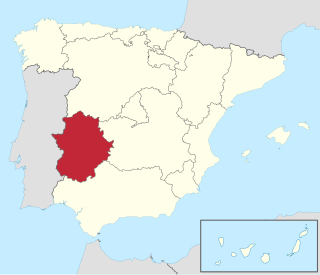
Extremadura is a landlocked autonomous community of Spain. Its capital city is Mérida, and its largest city is Badajoz. Located in the central-western part of the Iberian Peninsula, it is crossed from east to west by the Tagus and Guadiana rivers. The autonomous community is formed by the two largest provinces of Spain: Cáceres and Badajoz. Extremadura is bordered by Portugal to the west and by the autonomous communities of Castile and León (north), Castilla–La Mancha (east), and Andalusia (south).

Castilla–La Mancha is an autonomous community of Spain. Comprising the provinces of Albacete, Ciudad Real, Cuenca, Guadalajara and Toledo, it was created in 1982. The government headquarters are in Toledo, which is the capital de facto.

Guadalajara is a city and municipality in Spain, located in the autonomous community of Castilla–La Mancha. It is the capital of the Province of Guadalajara.
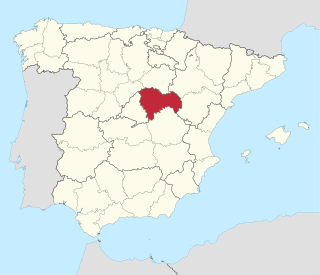
Guadalajara is a province of Spain, belonging to the autonomous community of Castilla–La Mancha. As of 2019 it had a population of 258,890 people. The population of the province has grown in the last 10 years. It is located in the centre of the Iberian Peninsula.

The Manzanares is a river in the centre of the Iberian Peninsula, which flows from the Sierra de Guadarrama, passes through Madrid, and eventually empties into the Jarama river, which in turn is a right-bank tributary to the Tagus.
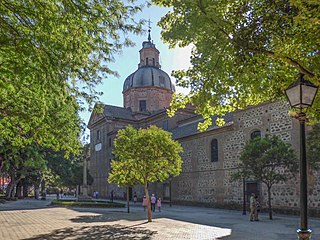
Talavera de la Reina is a city and municipality of Spain, part of the autonomous community of Castile–La Mancha. Its population of 83,303 makes it the second most populated municipality of the province of Toledo and the fourth largest in the region.
Pastrana is a municipality in the province of Guadalajara, Castilla–La Mancha, Spain. As of 1 January 2022, it had a registered population of 850. The municipality spans across a total area of 95.70 km2.

Ocaña is a municipality of Spain, in the province of Toledo, Castilla–La Mancha.

Puertollano is a municipality of Spain located in the province of Ciudad Real, Castile-La Mancha. The city has a population of 45,539 (2022). Contrasting to the largely rural character of the region, Puertollano stands out for the importance of industry, with a past linked to industrial and mining activities. It lies on the AVE high-speed train line linking Madrid and Seville.

La Alcarria, also referred to as the Alcarria in English, is a natural region in Castile, central Spain, located mainly in Guadalajara Province but also overlapping those of Cuenca and Madrid. Its principal attractions are its fauna and flora and it is noted for its honey, olives, and a special breed of lamb.

The Bueno River is a river in southern Chile. It originates in Ranco Lake and like most of Chile rivers it drains into the Pacific Ocean at the southern boundary of the Valdivian Coastal Reserve. Its lower flow forms the border between Osorno Province and Ranco Province. Traditionally, it marks also the northern boundary of the indigenous Huilliche territory known as Futahuillimapu. The river passes through Río Bueno commune and city that takes name from the river.

The Guadalimar is a river of the Iberian Peninsula, a right-bank tributary of the Guadalquivir. Its 180-km long course spans across the Spanish provinces of Albacete and Jaén.

The Tagus-Segura Water Transfer is one of the largest works of hydraulic engineering ever produced in Spain. Water from the Tagus River is channeled through this transfer system from the reservoirs of Entrepeñas and Buendía into the Talave Reservoir on the Segura River.

The Guadyerbas is a river of Spain located in the centre of the Iberian Peninsula. It is the main left-bank tributary of the Tiétar, in turn a major tributary of the Tagus.
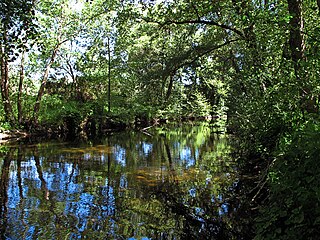
The Guadalix is a river of Spain located in the centre of the Iberian Peninsula, a right-bank tributary of the Jarama.

José María Jimeno Jurío, was a Basque anthropologist, ethnographer, and priest.
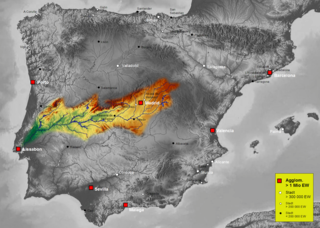
The Tagus Basin is the drainage basin of the Tagus River, which flows through the west of the Iberian Peninsula and empties into Lisbon. It covers an area of 78,467 km2, which is distributed 66% on Spanish territory and 34% on Portuguese land (22,822 km2).

The Ebro Hydrographic Confederation is the organization that manages, regulates and maintains the water and irrigation of the Ebro hydrographic basin. The organization's headquarters are in Zaragoza and it was the first institution created in the world with the objective of managing an entire river basin in a unitary manner.



















